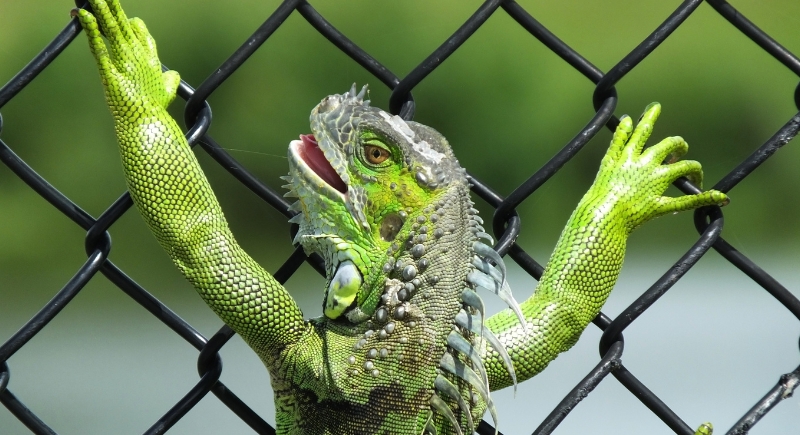The Most Effective Way to Deal With an Iguana Infestation
In Florida, iguanas are no longer just the occasional surprise sunning themselves on a patio. They’ve become an everyday problem. They can be seen chewing through gardens, digging burrows that weaken seawalls, and multiplying fast enough to overwhelm backyards. What once felt like a quirky encounter with wildlife has turned into a constant, costly hassle for homeowners.
One video on TikTok shows how to deal with Florida’s ever-growing iguana problem: a man wrapping a sheet of metal around the trunk of his tree to keep the lizards from climbing up. The simple trick struck a nerve and resonated with viewers who are also searching for practical ways to keep the invasive reptiles at bay.
Why Iguanas Are a Problem

Image via Getty Images/passion4nature
Iguanas were introduced through the pet trade and spread quickly once released into the wild. While they may look harmless, they destroy gardens, strip flowers, and dig burrows that compromise sidewalks and seawalls. Their droppings around pools and patios can spread salmonella, which can create health concerns in addition to property damage.
Iguanas are not naturally aggressive, but they will defend themselves if cornered. Their tails can whip with force, and their bites and scratches can injure. Adults can grow up to six feet long. This combination of size, strength, and destructive habits makes control necessary.
Early signs of iguanas on your property include droppings, scratches on fences or trees, bite marks on plants, and small burrow holes. Sightings during the day are common since they bask in the sun. Recognizing these indicators helps prevent a larger infestation from taking hold.
Making Your Yard Less Appealing
The simplest way to manage iguanas is to remove what attracts them. The metal tree-wrap trick works because smooth barriers block climbing. Filling burrows with rocks denies nesting space, while trimming thick shrubs reduces shelter. L-shaped wire barriers along seawalls stop digging. Even spraying them with a hose or using reflective items like CDs can discourage them.
Plant choices also help. Iguanas target hibiscus, roses, impatiens, and melons. In contrast, citrus trees, oleanders, pigeon plum, and coonties are unappealing. Toxic leafy greens such as spinach, Swiss chard, broccoli, and turnips make good protective borders around vulnerable crops. Adjusting the plants in your yard can reduce their interest in the area.
Do Repellents Work?

Image via Canva/Virrage Images Inc
Strong smells confuse iguanas’ sense of taste and smell. Citrus, lemongrass, citronella, garlic, hot peppers, and cedarwood are commonly used. Neem oil sprays can also be effective. Essential oils applied around gardens and pool areas help create boundaries. Mothballs, however, are not a solution. They produce odor but don’t work at safe levels.
When to Call the Pros
Home methods can help, but persistent infestations often need professional removal. State laws sometimes prohibit releasing trapped iguanas, so handling them without training can lead to legal and safety issues. Licensed specialists know how to trap and remove them humanely while identifying risks like burrows near foundations. Choosing experts with experience and proper certification ensures compliance with regulations.
Staying Iguana-Free
Long-term success comes from monitoring and upkeep. Regularly check for new burrows, droppings, or plant damage. Reinforce barriers and sprays when needed, and share information with neighbors to prevent re-infestation.
Iguanas may seem like exotic visitors, but in Florida, they are destructive pests. Prevention, property adjustments, and professional services together form the most effective approach to keeping them out.